Abstract
The effects of exogenous oleate on glucose uptake, lactate production and glycogen concentration in resting and contracting skeletal muscle were studied in the perfused rat hindquarter. In preliminary studies with aged erythrocytes at a haemoglobin concentration of 8g/100ml in the perfusion medium, 1.8mm-oleate had no effect on glucose uptake or lactate production. During these studies it became evident that O2 delivery was inadequate with aged erythrocytes. Perfusion with rejuvenated human erythrocytes at a haemoglobin concentration of 12g/100ml resulted in a 2-fold higher O2 uptake at rest and a 4-fold higher O2 uptake during muscle contraction than was obtained with aged erythrocytes. Rejuvenated erythrocytes were therefore used in subsequent experiments. Glucose uptake and lactate production by the well-oxygenated hindquarter were inhibited by one-third, both at rest and during muscle contraction, when 1.8mm-oleate was added to the perfusion medium. Addition of oleate also significantly protected against glycogen depletion in the fast-twitch red and slow-twitch red types of muscle, but not in white muscle, during sciatic-nerve stimulation. In the absence of added oleate, glucose was confined to the extracellular space in resting muscle. Addition of oleate resulted in intracellular glucose accumulation in red muscle. Contractile activity resulted in accumulation of intracellular glucose in all three muscle types, and this effect was significantly augmented in the red types of muscle by perfusion with oleate. The concentrations of citrate and glucose 6-phosphate were also increased in red muscle perfused with oleate. We conclude that, as in the heart, availability of fatty acids has an inhibitory effect on glucose uptake and glycogen utilization in well-oxygenated red skeletal muscle.
Full text
PDF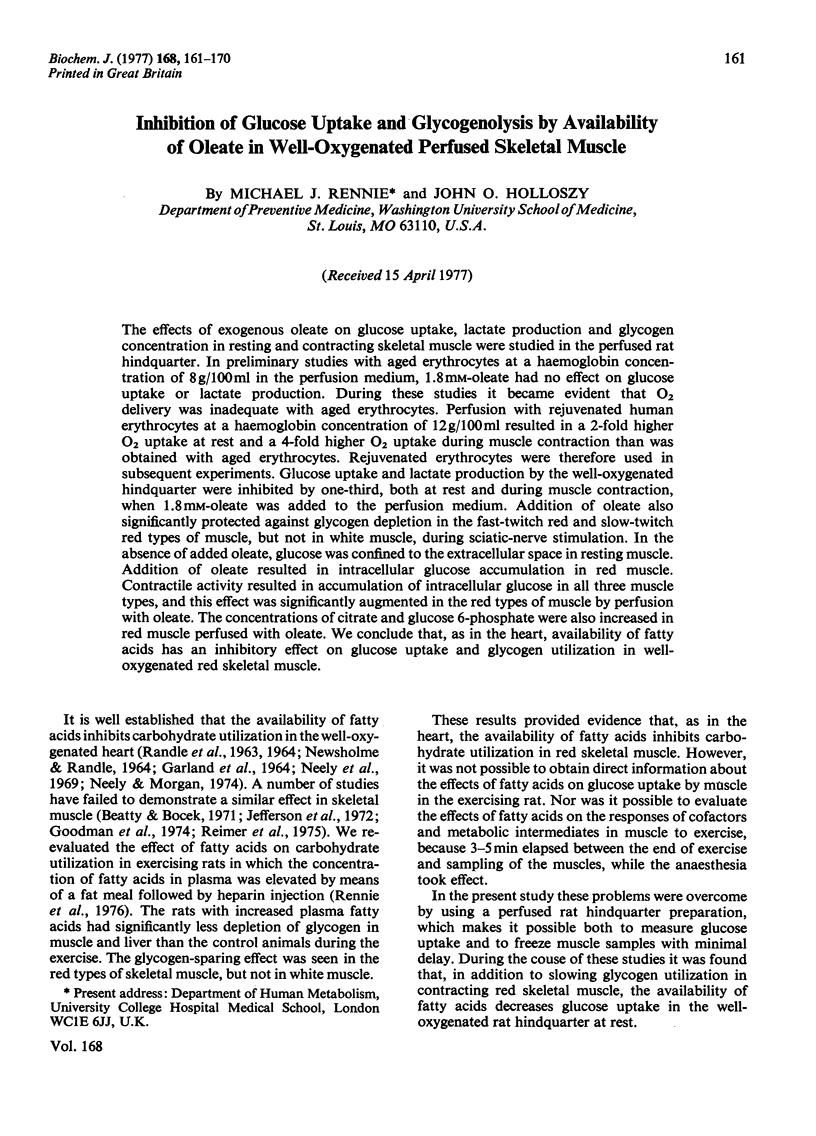
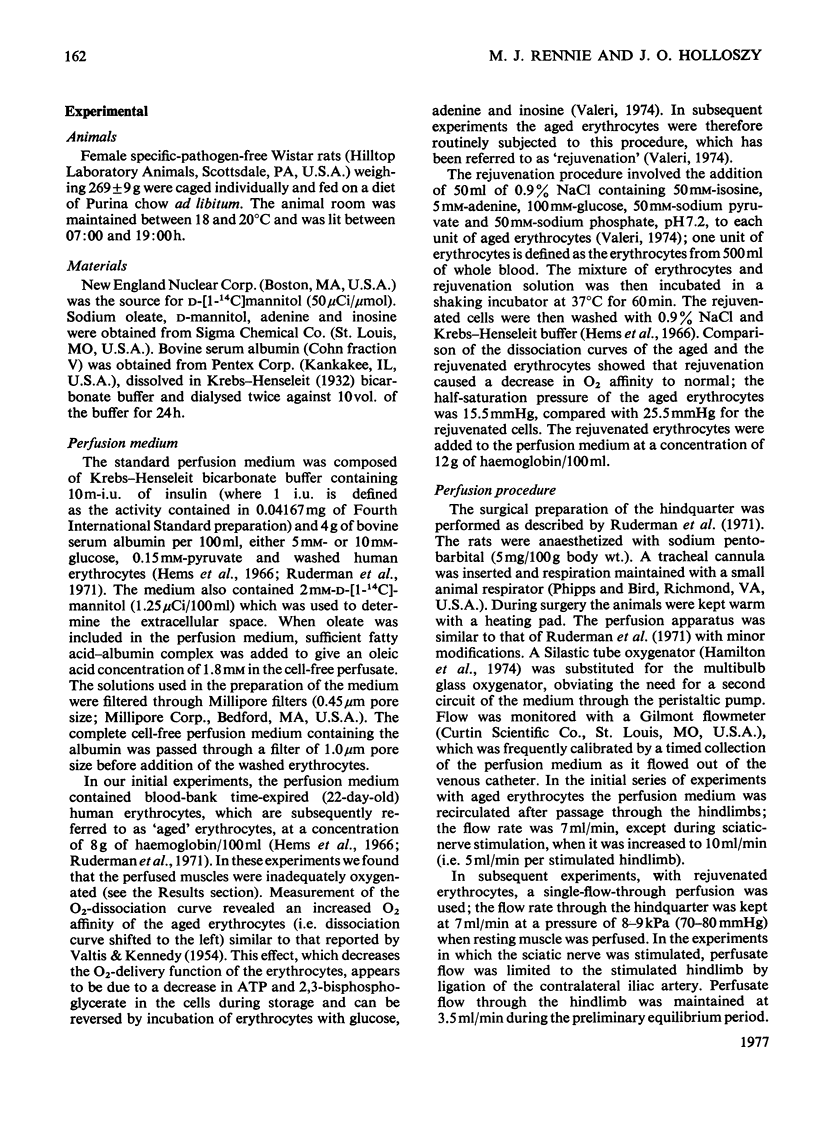
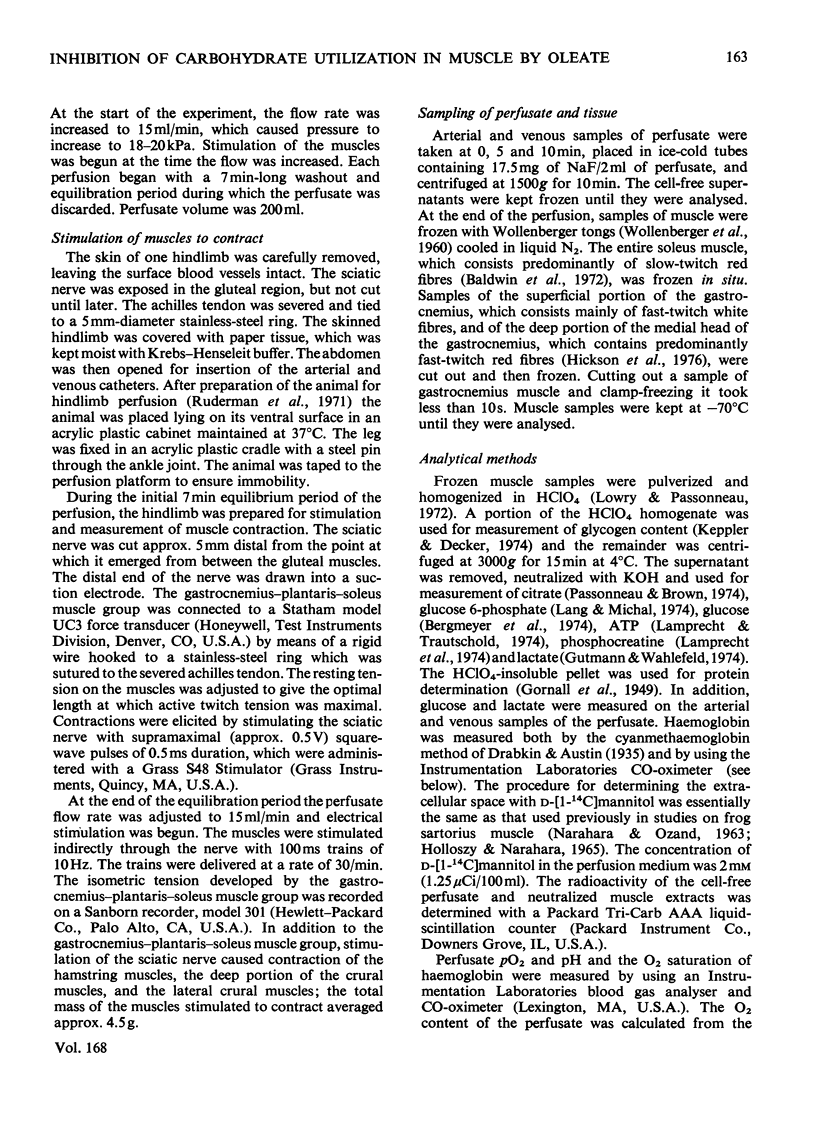
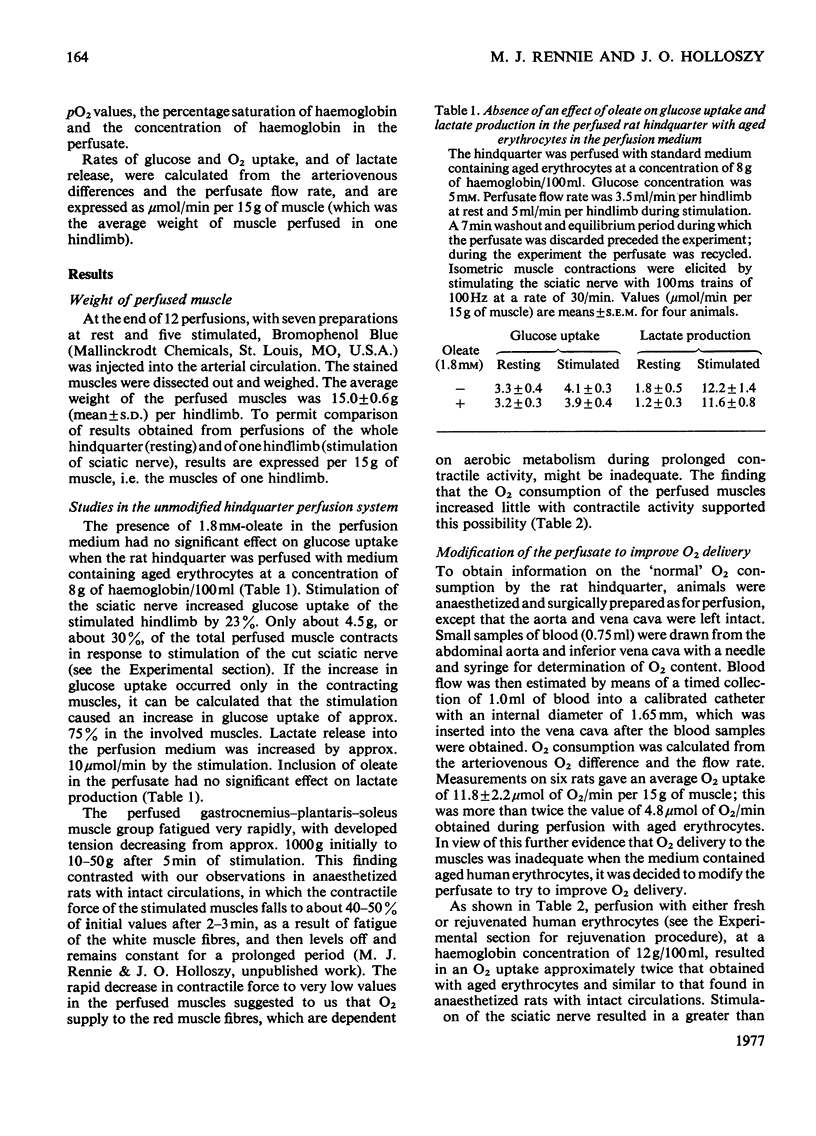
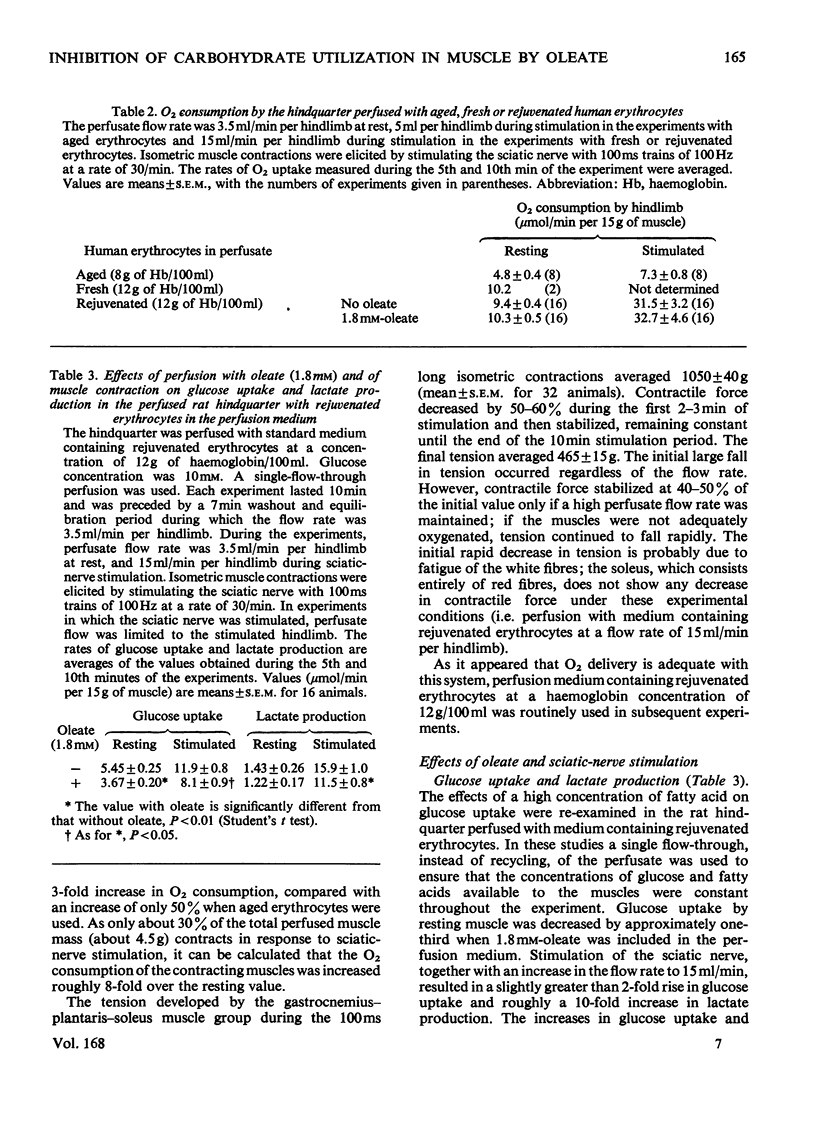
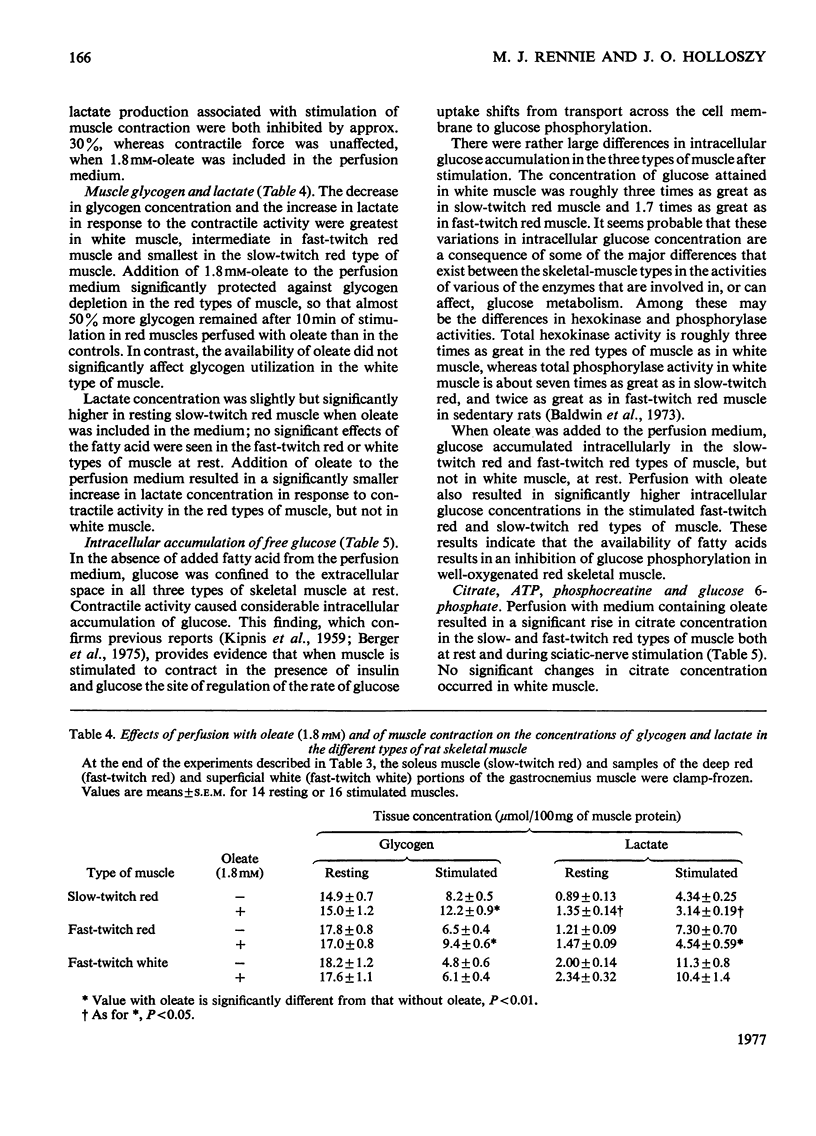
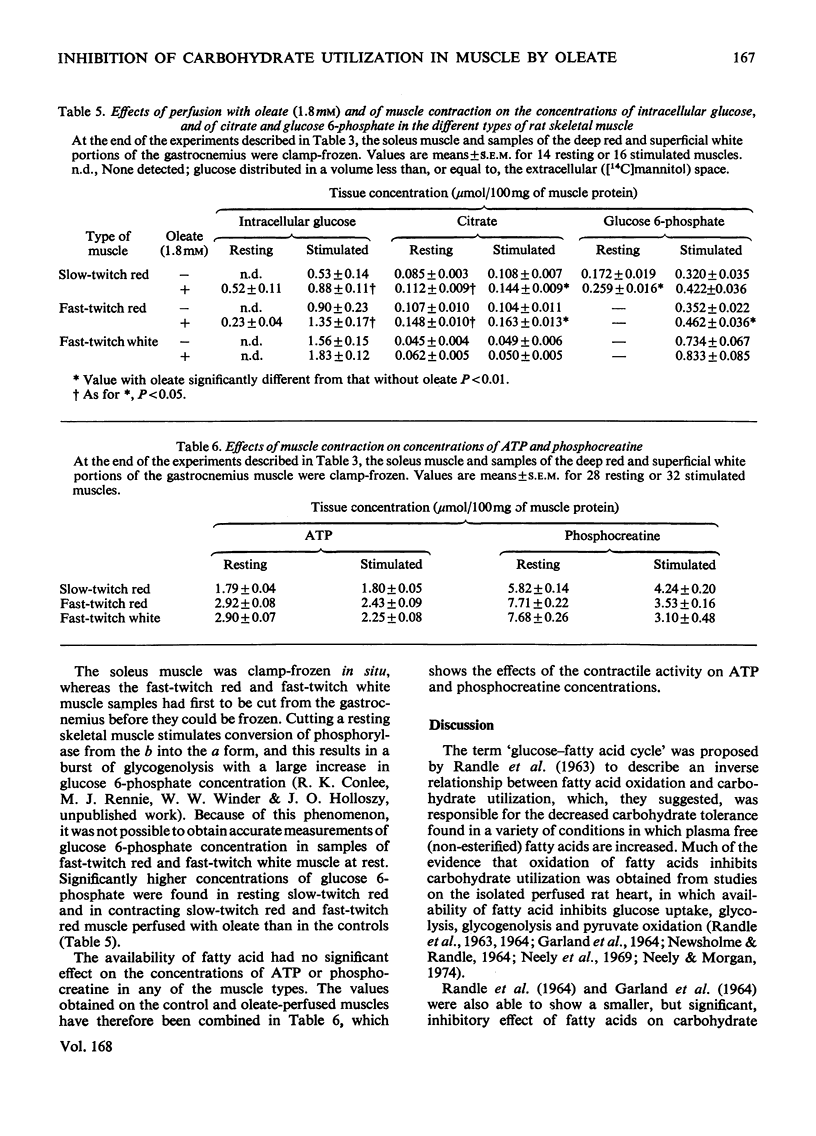
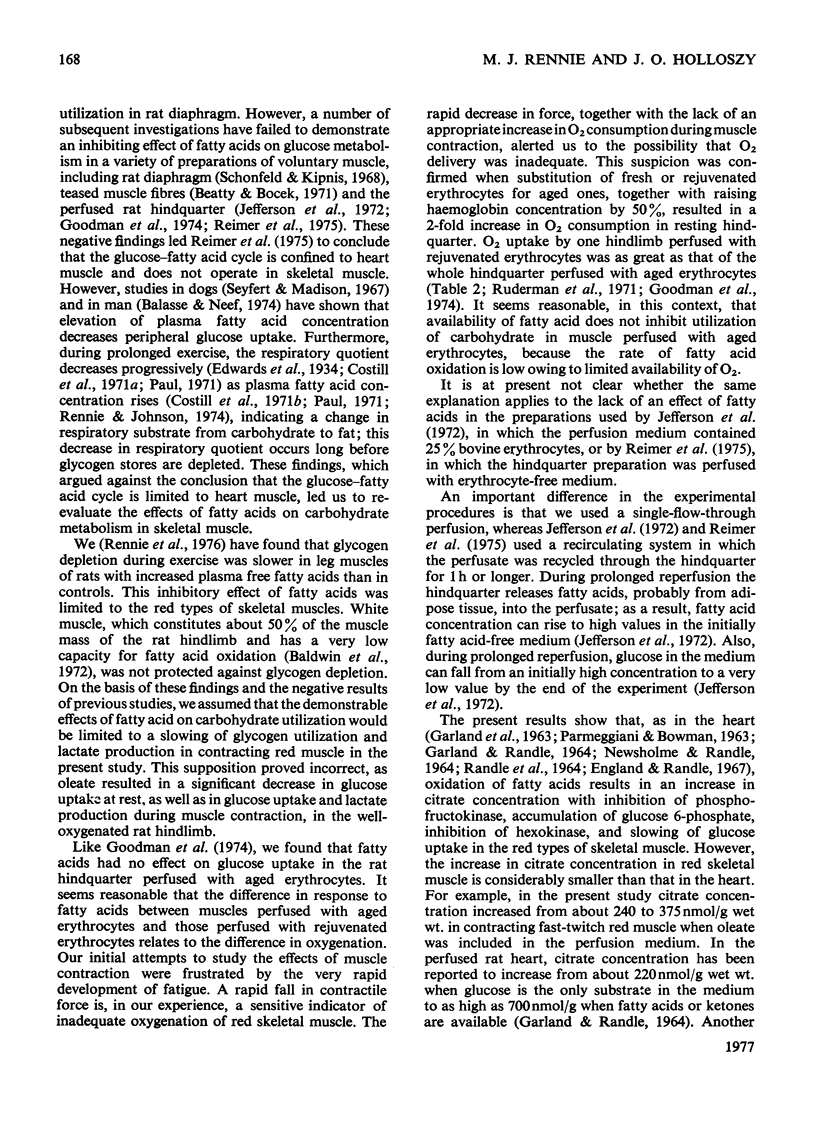
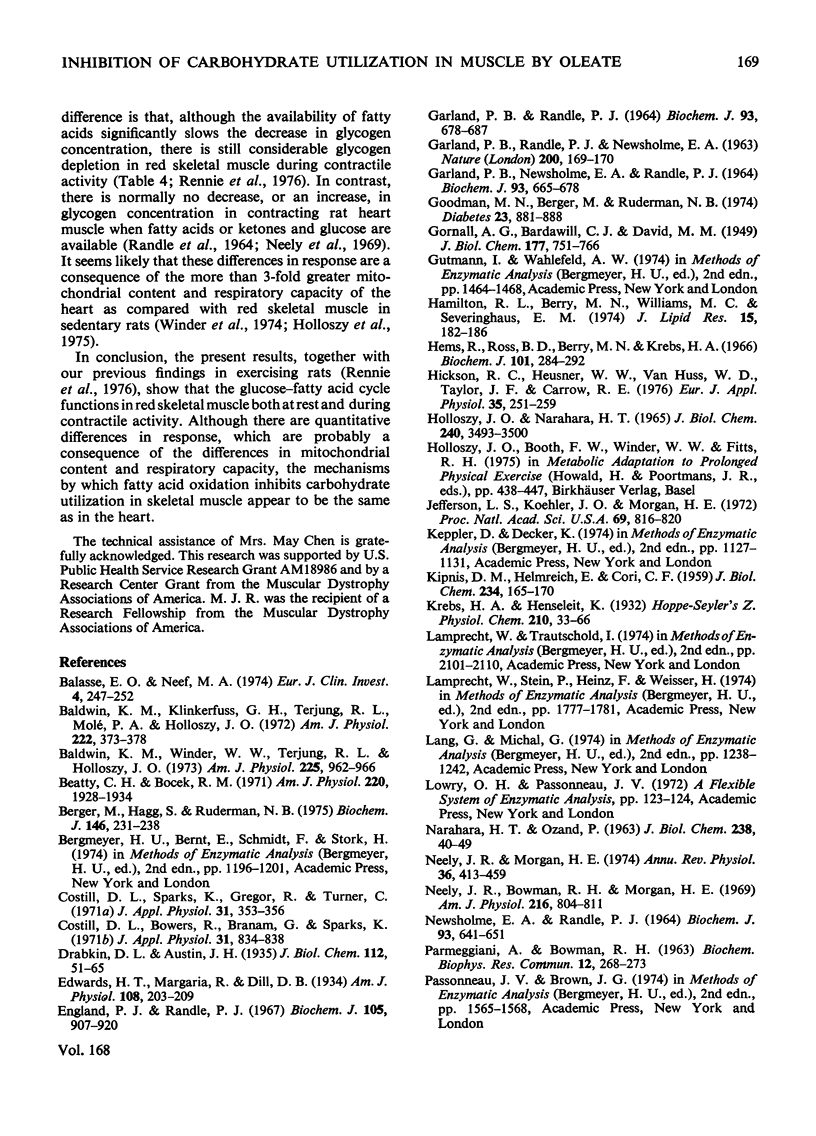
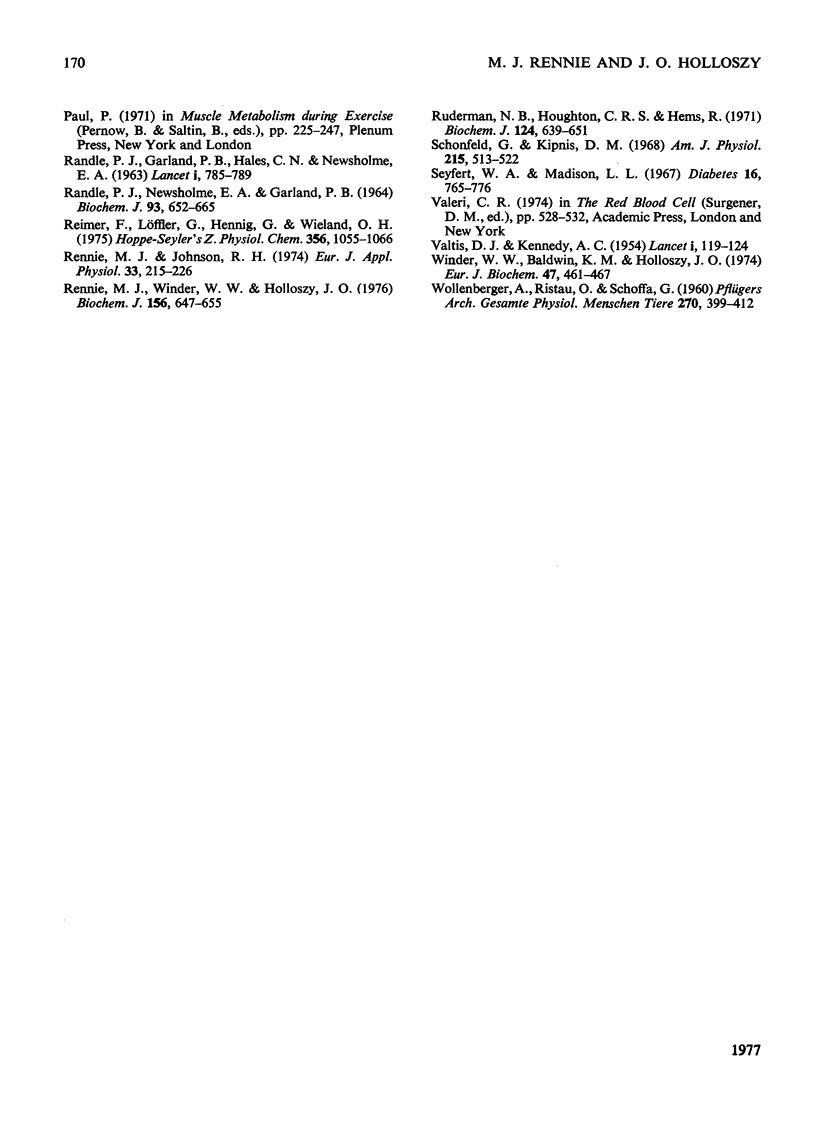
Selected References
These references are in PubMed. This may not be the complete list of references from this article.
- Balasse E. O., Neef M. A. Operation of the "glucose-fatty acid cycle" during experimental elevations of plasma free fatty acid levels in man. Eur J Clin Invest. 1974 Aug;4(4):247–252. doi: 10.1111/j.1365-2362.1974.tb00400.x. [DOI] [PubMed] [Google Scholar]
- Baldwin K. M., Klinkerfuss G. H., Terjung R. L., Molé P. A., Holloszy J. O. Respiratory capacity of white, red, and intermediate muscle: adaptative response to exercise. Am J Physiol. 1972 Feb;222(2):373–378. doi: 10.1152/ajplegacy.1972.222.2.373. [DOI] [PubMed] [Google Scholar]
- Baldwin K. M., Winder W. W., Terjung R. L., Holloszy J. O. Glycolytic enzymes in different types of skeletal muscle: adaptation to exercise. Am J Physiol. 1973 Oct;225(4):962–966. doi: 10.1152/ajplegacy.1973.225.4.962. [DOI] [PubMed] [Google Scholar]
- Beatty C. H., Bocek R. M. Interrelation of carbohydrate and palmitate metabolism in skeletal muscle. Am J Physiol. 1971 Jun;220(6):1928–1934. doi: 10.1152/ajplegacy.1971.220.6.1928. [DOI] [PubMed] [Google Scholar]
- Berger M., Hagg S., Ruderman N. B. Glucose metabolism in perfused skeletal muscle. Interaction of insulin and exercise on glucose uptake. Biochem J. 1975 Jan;146(1):231–238. doi: 10.1042/bj1460231. [DOI] [PMC free article] [PubMed] [Google Scholar]
- Costill D. L., Bowers R., Branam G., Sparks K. Muscle glycogen utilization during prolonged exercise on successive days. J Appl Physiol. 1971 Dec;31(6):834–838. doi: 10.1152/jappl.1971.31.6.834. [DOI] [PubMed] [Google Scholar]
- Costill D. L., Sparks K., Gregor R., Turner C. Muscle glycogen utilization during exhaustive running. J Appl Physiol. 1971 Sep;31(3):353–356. doi: 10.1152/jappl.1971.31.3.353. [DOI] [PubMed] [Google Scholar]
- England P. J., Randle P. J. Effectors of rat-heart hexokinases and the control of rates of glucose phosphorylation in the perfused rat heart. Biochem J. 1967 Dec;105(3):907–920. doi: 10.1042/bj1050907. [DOI] [PMC free article] [PubMed] [Google Scholar]
- GARLAND P. B., RANDLE P. J., NEWSHOLME E. A. CITRATE AS AN INTERMEDIARY IN THE INHIBITION OF PHOSPHOFRUCTOKINASE IN RAT HEART MUSCLE BY FATTY ACIDS, KETONE BODIES, PYRUVATE, DIABETES, AND STARVATION. Nature. 1963 Oct 12;200:169–170. doi: 10.1038/200169a0. [DOI] [PubMed] [Google Scholar]
- Garland P. B., Newsholme E. A., Randle P. J. Regulation of glucose uptake by muscle. 9. Effects of fatty acids and ketone bodies, and of alloxan-diabetes and starvation, on pyruvate metabolism and on lactate-pyruvate and L-glycerol 3-phosphate-dihydroxyacetone phosphate concentration ratios in rat heart and rat diaphragm muscles. Biochem J. 1964 Dec;93(3):665–678. doi: 10.1042/bj0930665. [DOI] [PMC free article] [PubMed] [Google Scholar]
- Garland P. B., Randle P. J. Regulation of glucose uptake by muscles. 10. Effects of alloxan-diabetes, starvation, hypophysectomy and adrenalectomy, and of fatty acids, ketone bodies and pyruvate, on the glycerol output and concentrations of free fatty acids, long-chain fatty acyl-coenzyme A, glycerol phosphate and citrate-cycle intermediates in rat heart and diaphragm muscles. Biochem J. 1964 Dec;93(3):678–687. doi: 10.1042/bj0930678. [DOI] [PMC free article] [PubMed] [Google Scholar]
- Goodman M. N., Berger M., Ruderman N. B. Glucose metabolism in rat skeletal muscle at rest. Effect of starvation, diabetes, ketone bodies and free fatty acids. Diabetes. 1974 Nov;23(11):881–888. doi: 10.2337/diab.23.11.881. [DOI] [PubMed] [Google Scholar]
- Hamilton R. L., Berry M. N., Williams M. C., Severinghaus E. M. A simple and inexpensive membrane "lung" for small organ perfusion. J Lipid Res. 1974 Mar;15(2):182–186. [PubMed] [Google Scholar]
- Hems R., Ross B. D., Berry M. N., Krebs H. A. Gluconeogenesis in the perfused rat liver. Biochem J. 1966 Nov;101(2):284–292. doi: 10.1042/bj1010284. [DOI] [PMC free article] [PubMed] [Google Scholar]
- Hickson R. C., Heusner W. W., Van Huss W. D., Taylor J. F., Carrow R. E. Effects of an anabolic steroid and sprint training on selected histochemical and morphological observations in rat skeletal muscle types. Eur J Appl Physiol Occup Physiol. 1976 Sep 23;35(4):251–259. doi: 10.1007/BF00423284. [DOI] [PubMed] [Google Scholar]
- Holloszy J. O., Narahara H. T. Studies of tissue permeability. X. Changes in permeability to 3-methylglucose associated with contraction of isolated frog muscle. J Biol Chem. 1965 Sep;240(9):3493–3500. [PubMed] [Google Scholar]
- Jefferson L. S., Koehler J. O., Morgan H. E. Effect of insulin on protein synthesis in skeletal muscle of an isolated perfused preparation of rat hemicorpus. Proc Natl Acad Sci U S A. 1972 Apr;69(4):816–820. doi: 10.1073/pnas.69.4.816. [DOI] [PMC free article] [PubMed] [Google Scholar]
- KIPNIS D. M., HELMREICH E., CORI C. F. Studies of tissue permeability. IV. The distribution of glucose between plasma and muscle. J Biol Chem. 1959 Jan;234(1):165–170. [PubMed] [Google Scholar]
- NARAHARA H. T., OZAND P. Studies of tissue permeability. IX. The effect of insulin on the penetration of 3-methylglucose-H3 in frog muscle. J Biol Chem. 1963 Jan;238:40–49. [PubMed] [Google Scholar]
- Neely J. R., Bowman R. H., Morgan H. E. Effects of ventricular pressure development and palmitate on glucose transport. Am J Physiol. 1969 Apr;216(4):804–811. doi: 10.1152/ajplegacy.1969.216.4.804. [DOI] [PubMed] [Google Scholar]
- Newsholme E. A., Randle P. J. Regulation of glucose uptake by muscle. 7. Effects of fatty acids, ketone bodies and pyruvate, and of alloxan-diabetes, starvation, hypophysectomy and adrenalectomy, on the concentrations of hexose phosphates, nucleotides and inorganic phosphate in perfused rat heart. Biochem J. 1964 Dec;93(3):641–651. doi: 10.1042/bj0930641. [DOI] [PMC free article] [PubMed] [Google Scholar]
- PARMEGGIANI A., BOWMAN R. H. REGULATION OF PHOSPHOFRUCTOKINASE ACTIVITY BY CITRATE IN NORMAL AND DIABETIC MUSCLE. Biochem Biophys Res Commun. 1963 Aug 1;12:268–273. doi: 10.1016/0006-291x(63)90294-8. [DOI] [PubMed] [Google Scholar]
- RANDLE P. J., GARLAND P. B., HALES C. N., NEWSHOLME E. A. The glucose fatty-acid cycle. Its role in insulin sensitivity and the metabolic disturbances of diabetes mellitus. Lancet. 1963 Apr 13;1(7285):785–789. doi: 10.1016/s0140-6736(63)91500-9. [DOI] [PubMed] [Google Scholar]
- Randle P. J., Newsholme E. A., Garland P. B. Regulation of glucose uptake by muscle. 8. Effects of fatty acids, ketone bodies and pyruvate, and of alloxan-diabetes and starvation, on the uptake and metabolic fate of glucose in rat heart and diaphragm muscles. Biochem J. 1964 Dec;93(3):652–665. doi: 10.1042/bj0930652. [DOI] [PMC free article] [PubMed] [Google Scholar]
- Reimer F., Löffler G., Hennig G., Wieland O. H. The influence of insulin on glucose and fatty acid metabolism in the isolated perfused rat hind quarter. Hoppe Seylers Z Physiol Chem. 1975 Jun;356(6):1055–1066. doi: 10.1515/bchm2.1975.356.s1.1055. [DOI] [PubMed] [Google Scholar]
- Rennie M. J., Johnson R. H. Alteration of metabolic and hormonal responses to exercise by physical training. Eur J Appl Physiol Occup Physiol. 1974;33(3):215–226. doi: 10.1007/BF00421149. [DOI] [PubMed] [Google Scholar]
- Rennie M. J., Winder W. W., Holloszy J. O. A sparing effect of increased plasma fatty acids on muscle and liver glycogen content in the exercising rat. Biochem J. 1976 Jun 15;156(3):647–655. doi: 10.1042/bj1560647. [DOI] [PMC free article] [PubMed] [Google Scholar]
- Ruderman N. B., Houghton C. R., Hems R. Evaluation of the isolated perfused rat hindquarter for the study of muscle metabolism. Biochem J. 1971 Sep;124(3):639–651. doi: 10.1042/bj1240639. [DOI] [PMC free article] [PubMed] [Google Scholar]
- Schonfeld G., Kipnis D. M. Effects of fatty acids on carbohydrate and fatty acid metabolism of rat diaphragm. Am J Physiol. 1968 Aug;215(2):513–522. doi: 10.1152/ajplegacy.1968.215.2.513. [DOI] [PubMed] [Google Scholar]
- Seyffert W. A., Jr, Madison L. L. Physiologic effects of metabolic fuels on carbohydrate metabolism. I. Acute effect of elevation of plasma free fatty acids on hepatic glucose output, peripheral glucose utilization, serum insulin, and plasma glucagon levels. Diabetes. 1967 Nov;16(11):765–776. doi: 10.2337/diab.16.11.765. [DOI] [PubMed] [Google Scholar]
- VALTIS D. J. Defective gas-transport function of stored red blood-cells. Lancet. 1954 Jan 16;266(6803):119–124. doi: 10.1016/s0140-6736(54)90978-2. [DOI] [PubMed] [Google Scholar]
- WOLLENBERGER A., RISTAU O., SCHOFFA G. [A simple technic for extremely rapid freezing of large pieces of tissue]. Pflugers Arch Gesamte Physiol Menschen Tiere. 1960;270:399–412. [PubMed] [Google Scholar]
- Winder W. W., Baldwin K. M., Holloszy J. O. Enzymes involved in ketone utilization in different types of muscle: adaptation to exercise. Eur J Biochem. 1974 Sep 16;47(3):461–467. doi: 10.1111/j.1432-1033.1974.tb03713.x. [DOI] [PubMed] [Google Scholar]


